deployment of the PLA Navy ships in the - Information Resource ...
deployment of the PLA Navy ships in the - Information Resource ...
deployment of the PLA Navy ships in the - Information Resource ...
Create successful ePaper yourself
Turn your PDF publications into a flip-book with our unique Google optimized e-Paper software.
FFFFFFFFFFFFFFFFFFF<br />
Advanced Mar<strong>in</strong>e Eng<strong>in</strong>eer<strong>in</strong>g Course, popularly<br />
called <strong>the</strong> Dagger “E” cont<strong>in</strong>ued to be availed <strong>of</strong> <strong>in</strong> U.K.<br />
till 1972, when a specialized facility was set up at <strong>the</strong><br />
Institute <strong>of</strong> Armament Technology, Pune, some 40<br />
miles <strong>of</strong>f Lonavala.<br />
From <strong>the</strong> above, it becomes amply clear that<br />
both <strong>the</strong> basic and <strong>the</strong> advanced Mar<strong>in</strong>e Eng<strong>in</strong>eer<strong>in</strong>g<br />
Courses have been completed and successfully<br />
established <strong>in</strong> India even to <strong>the</strong> extent <strong>of</strong> attract<strong>in</strong>g<br />
foreign students from <strong>the</strong> Navies <strong>of</strong> <strong>the</strong> develop<strong>in</strong>g<br />
countries. A few eng<strong>in</strong>eer <strong>of</strong>ficers, however,<br />
cont<strong>in</strong>ued to be sent to UK for Dagger “E” and RCDS<br />
as a matter <strong>of</strong> goodwill.<br />
ICE Tra<strong>in</strong><strong>in</strong>g Complex (1964)<br />
The acquisition <strong>of</strong> <strong>the</strong> Type 41 Leopard class<br />
A/A frigates fitted with ASR 1 and ASR 2 diesel eng<strong>in</strong>es<br />
with block tube control and hydraulic fluid coupl<strong>in</strong>gs<br />
by <strong>the</strong> Indian <strong>Navy</strong> <strong>in</strong> 1961, led to <strong>the</strong> sett<strong>in</strong>g up <strong>of</strong><br />
diesel eng<strong>in</strong>e facility complex <strong>in</strong> 1964. This led to <strong>the</strong><br />
classification <strong>of</strong> eng<strong>in</strong>e-room sailors <strong>in</strong>to <strong>the</strong> IC stream<br />
and steam stream depend<strong>in</strong>g upon <strong>the</strong> specialization.<br />
Leander (Steam) Tra<strong>in</strong><strong>in</strong>g Complex (1978)<br />
This complex came up <strong>in</strong> 1978 with <strong>the</strong> exact<br />
replica <strong>of</strong> <strong>the</strong> entire range <strong>of</strong> ma<strong>in</strong> and auxiliary<br />
mach<strong>in</strong>ery as fitted on a Leander frigate. Though <strong>the</strong><br />
first <strong>in</strong>digenously built Leander INS Nilgiri was<br />
commissioned <strong>in</strong> Dec 1971, it can be seen that <strong>the</strong><br />
shore tra<strong>in</strong><strong>in</strong>g facility came up only 7 years later,<br />
<strong>the</strong>reby <strong>in</strong>dicat<strong>in</strong>g a major mismatch between <strong>the</strong><br />
time <strong>of</strong> acquisition <strong>of</strong> ship and <strong>the</strong> sett<strong>in</strong>g up <strong>of</strong> <strong>the</strong><br />
tra<strong>in</strong><strong>in</strong>g facilities ashore. The Leander project was<br />
made feasible ma<strong>in</strong>ly due to <strong>the</strong> support and<br />
cooperation extended by <strong>the</strong> Admiralty by way <strong>of</strong><br />
supply <strong>of</strong> manufactur<strong>in</strong>g draw<strong>in</strong>gs, exquipment, test<br />
FFFFFFFFF<br />
SEPTEMBER 2010<br />
equipments and tra<strong>in</strong><strong>in</strong>g <strong>of</strong> personnel. This served<br />
as an excellent example <strong>of</strong> cooperation between <strong>the</strong><br />
two navies. The Leanders brought <strong>in</strong> its wake <strong>the</strong> entry<br />
<strong>of</strong> Dieso-burn<strong>in</strong>g with steam atomization and a<br />
pneumatic control mach<strong>in</strong>ery room – big leap from<br />
FFO burn<strong>in</strong>g.<br />
Gas Turb<strong>in</strong>e Tra<strong>in</strong><strong>in</strong>g W<strong>in</strong>g (1986)<br />
The early 70’s saw a turn<strong>in</strong>g po<strong>in</strong>t <strong>in</strong> <strong>the</strong> policy<br />
<strong>of</strong> acquisition <strong>of</strong> <strong>ships</strong>. Most <strong>of</strong> <strong>the</strong> acquisitions that<br />
followed <strong>in</strong> 70’s and <strong>the</strong>reafter, ma<strong>in</strong>ly came from <strong>the</strong><br />
far East (USSR); heralded by <strong>the</strong> OSA class <strong>of</strong> fast patrol<br />
boats which were effectively put <strong>in</strong> action <strong>in</strong> <strong>the</strong> Indo-<br />
Pak 1971 war. The 80’s saw <strong>the</strong> acquisition <strong>of</strong> Kash<strong>in</strong><br />
class <strong>of</strong> destroyers which led to <strong>the</strong> sett<strong>in</strong>g up <strong>of</strong> <strong>the</strong><br />
Gas Turb<strong>in</strong>e tra<strong>in</strong><strong>in</strong>g w<strong>in</strong>g <strong>in</strong> 1986. This is regarded<br />
as a big leap <strong>in</strong> <strong>the</strong> propulsion field from steam to diesel<br />
and now to gas. It, at once, became clear that <strong>the</strong><br />
Indian <strong>Navy</strong> has matured and grown to stature so as<br />
to be a force to reckon with. The gas turb<strong>in</strong>e driven<br />
vessel added extra teeth and punch to our <strong>Navy</strong>. It<br />
also <strong>in</strong>troduced a different type <strong>of</strong> tra<strong>in</strong><strong>in</strong>g philosophy<br />
namely, <strong>the</strong> vertical type <strong>of</strong> tra<strong>in</strong><strong>in</strong>g as practiced by <strong>the</strong><br />
Soviet <strong>Navy</strong>. The philosophy <strong>of</strong> <strong>the</strong> Soviet type <strong>of</strong><br />
tra<strong>in</strong><strong>in</strong>g is dist<strong>in</strong>ct from <strong>the</strong> generalized type <strong>of</strong> tra<strong>in</strong><strong>in</strong>g<br />
as acquired by us from <strong>the</strong> Royal <strong>Navy</strong>. Both have its<br />
merits and demerits. One cannot help recall<strong>in</strong>g <strong>the</strong><br />
words <strong>of</strong> Lord Haldane at this stage to put <strong>the</strong> above<br />
matter <strong>in</strong> a better perspective “It is only by <strong>the</strong><br />
possession <strong>of</strong> a tra<strong>in</strong>ed and developed m<strong>in</strong>d that <strong>the</strong><br />
fullest capacity can as a rule be obta<strong>in</strong>ed. There are,<br />
<strong>of</strong> course, exceptional <strong>in</strong>dividuals with rare natural<br />
gifts which make up for deficiencies. But such gifts are<br />
<strong>in</strong>deed rare. We are com<strong>in</strong>g more and more to<br />
recognize that <strong>the</strong> best specialist can be produced only<br />
after a long tra<strong>in</strong><strong>in</strong>g <strong>in</strong> general learn<strong>in</strong>g. The grasp <strong>of</strong><br />
pr<strong>in</strong>ciple which makes detail easy can only come<br />
when <strong>in</strong>ate capacity has been evoked and moulded<br />
by high tra<strong>in</strong><strong>in</strong>g”<br />
FFFFFFFFF 30




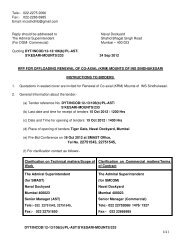
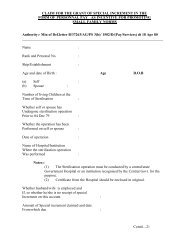
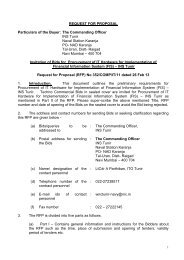

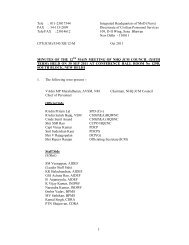
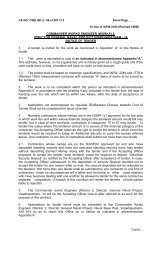

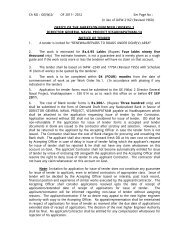

![DGNP[V] - Irfc-nausena.nic.in](https://img.yumpu.com/23509938/1/158x260/dgnpv-irfc-nausenanicin.jpg?quality=85)



